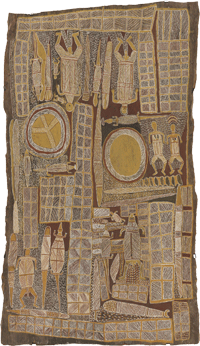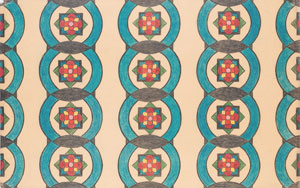The Long View
John Haberin New York City
Madayin: Aboriginal Bark Painting
Mary Sully
Can there have been a first Aboriginal work of art? Yes and no, and Asia Society gives it a room to itself, but against a backdrop of churning waters projected on the walls. These are ancestral waters, and painting itself has a history without a beginning, in ancestral practices—and, an exhibition explains, in "patterns of the ancestral land itself."
That conjunction, of practices known only to clan and community but there for all to see, guides "Madayin," eighty years of Aboriginal Australian bark painting. The title means both the sacred and the beautiful, which is to say both a ritual and (oh, dear) fine art—and that 1935 point of origins has a back story as well as a backdrop. A white investigator had taken up the cause of four men in prison for murder, and Wongu Munuŋgur thanked him with a painting.  Aboriginal painting had long worked in sand and on bare skin, but now it became reddish-brown pigment on eucalyptus bark. It became, too, the conjunction of the timeless and timely. Painters have been asking just how much to call it theirs ever since.
Aboriginal painting had long worked in sand and on bare skin, but now it became reddish-brown pigment on eucalyptus bark. It became, too, the conjunction of the timeless and timely. Painters have been asking just how much to call it theirs ever since.
Mary Sully, too, took the long view. It did not settle anything, but it did bring a kind of peace. The Met calls a selection of two dozen drawings "Native Modern," and she was equally at ease with Native American craft, Modernism, and her own rebellious spirit. She herself called them "personality prints," and they depict no end of other personalities as well from stage and screen. She produced many indeed from the 1920s through the 1940s, none of them dated. It is all she can do to encompass New York between the wars and her own mixed ancestry.
The ancestral land itself
The Aboriginal Australians live in Yirrkala, about halfway along Australia's remote northern coast, and Asia Society supplies a map. The Yolŋu "knowledge holders" who curated the show were not entirely comfortable with that. To them, what a scientist might call a reference frame or a colonizer a navigational aid is a betrayal. The Yolŋu themselves had no written language, just a multiplicity of spoken languages, until Europeans showed up. To this day, artists refuse to adopt the patterns of other clans—not, they insist, out of scorn but out of respect. If all this " primitive art" starts to look the same, do bear that in mind.
If it still looks much the same, it will always take the long view. That opening work rests on the floor like Native American tapestry, while other work hangs vertically with dominant vertical fields. They afford space for ancestral beings, including snakes, sharks and men. Fish might be swimming upward as if swimming upstream. They might also be swimming into a trap, part of the myths and patterns at play, too. Layered on top in thicker pigments, often white, are rocks and clouds.
These are sacred spaces, and they articulate gurrutu, or kinship. More precisely, they picture a kinship system, encompassing art, country, and the environment—or lands, stories, and fire. Short diagonals dart back and forth against the verticals. Everything runs freely, supplying points of unrest and stability. These artists could not draw a straight line with a ruler if they tried. But then that would be mapping.
Museums have made a point these days of hanging long-past art beside contemporaries, like the Met with Japan, Korea, and Tibet. Contemporary art sells, and board members are collectors. It makes sense, though, when a people refuses a time line or a map. Asia Society draws on the show's partners, the Kluge-Ruhe Aboriginal Art Collection of the University of Virginia and the Buku-Larrngay Mulka Centre in Australia, along with new commissions. It also starts all over again one floor up.
The restart introduces women. They began to paint in the 1930s, too. Forms in their hands become larger and more prominent, like a starlit sky for Nyapanyapa Yunupinu. (Could this be the Yolŋu Starry Night?) They show humans as active today or all but eliminate them on the way to abstraction. And then comes one last room for half a dozen contemporaries.
They recall another beginning nearly eighty years ago, in the United States. Carlene West looks to the Surrealism that Jackson Pollock once had to leave behind, Riko Rennie and others to geometry and color. They may send you back to the rest of the exhibition to see what, if anything, has changed as Aboriginal art enters the mainstream. From the start, one motive for painting on bark was to swap with outsiders for food and provisions, and now it has earned its place in New York. Besides, there is always one problem with seeing the world as a system: the more it grows, the more it can fall apart.
New York with reservations
Each drawing by Mary Sully has three parts, stacked vertically, for another kind of long view. Coming to Sully amid indigenous art in the Met's American wing, one might dismiss her work as more of the same. Her vertical format and obsessive patterning recall traditional blankets and dresses, and the museum throws in one of each for good measure. She herself cultivated the image of the unknown, self-taught artist in America's oldest Indian village. She appears on film, working away while dressed to the Native American nines. One can almost overlook the film's producer, Paramount Pictures.
 She knew her Dakota homeland, but she also knew New York, where her sister studied anthropology under Franz Boas at Columbia University. She celebrated Easter on Fifth Avenue and dedicated a drawing to Fiorello La Guardia, the New Deal mayor. She called another drawing Greed, lest there be any doubt that corporate interests brought on the Depression in the first place. In a drawing for Walter Winchell, the radio news anchor, Sully's zigzag patterns could be bursts of radio waves, carrying the city's message to the world. A drawing for Florenz Ziegfeld has at top a circle of pretty faces, right out of the Ziegfeld follies. Others allude to Alfred Lunt and Lynn Fontanne, the Broadway actors, but also a child actress, because sophistication is in the eye of the beholder.
She knew her Dakota homeland, but she also knew New York, where her sister studied anthropology under Franz Boas at Columbia University. She celebrated Easter on Fifth Avenue and dedicated a drawing to Fiorello La Guardia, the New Deal mayor. She called another drawing Greed, lest there be any doubt that corporate interests brought on the Depression in the first place. In a drawing for Walter Winchell, the radio news anchor, Sully's zigzag patterns could be bursts of radio waves, carrying the city's message to the world. A drawing for Florenz Ziegfeld has at top a circle of pretty faces, right out of the Ziegfeld follies. Others allude to Alfred Lunt and Lynn Fontanne, the Broadway actors, but also a child actress, because sophistication is in the eye of the beholder.
Sully cultivated her family history, too, in all its amalgams and contradictions. Her father, Philip J. Deloria, was an Episcopal minister in a Native American church, and a drawing depicts a ceremony. It has a minister at its center in a proper prayer shawl, while curtains to either side might be officiants themselves and seem to take on wings. She took her name, though, from her mother, herself of mixed ancestry. The young artist could not have minded that it also marks her as the great-granddaughter of Thomas Sully, the painter born in England. She could not have minded, too, that his parents were actors and his portraits include composers along with Thomas Jefferson.
She was taking the long view, too, in a triptych for Three Stages of Indian History. The patterned lower third may adapt "Pre-Columbian Freedom," while figures on the grass just above inhabit an idealized version of Standing Rock Reservation, her birthplace. That leaves the crowded silhouettes at top for "The Bewildering Present." Unless, of course, their dark outlines derive from Pre-Columbian pottery—and the wild zigzags for upheavals in Native American and modern art. Oh, and did I say that Sully titles that sunlit expanse "Reservation Fetters"? Freedom may not come easily.
The curators, Patricia Marroquin Norby and Sylvia Yount, single out one drawing for its "unusual ambiguity," but ambiguity for Sully comes with the territory. Elsewhere dark silhouettes could represent Depression-era labor, entertainers, or celebrants. The colorful patterns could derive from her ancestors or still-revolutionary abstract art. Often text appears at bottom, as a fourth panel, to identify the subject. One for Gertrude Stein quotes "rose is a rose is a rose is a rose." Repetition like that could be naïve or revolutionary, too—and, of course, patterning.
Not many artists back then were fluent in terms like "Pre-Columbian," and not many had a linguistic ethnographer for a sister. And how many could turn colored pencil and pastel crayons into drawing with the precision of ink and a softness akin to watercolor? Sully is no closer to fame, but then she had reservations about fame, even as she pursued it. One last triptych has a cart at top overflowing with flowers, a floral tapestry, and then the zigzags. It could mark the passage from the streets of New York to the reservation and finally to abstraction. Or it could run the other way, from abstraction to nature.

Aboriginal Australian bark painting ran at Asia Society through January 5, 2025, Mary Sully at The Metropolitan Museum of Art through January 12.




